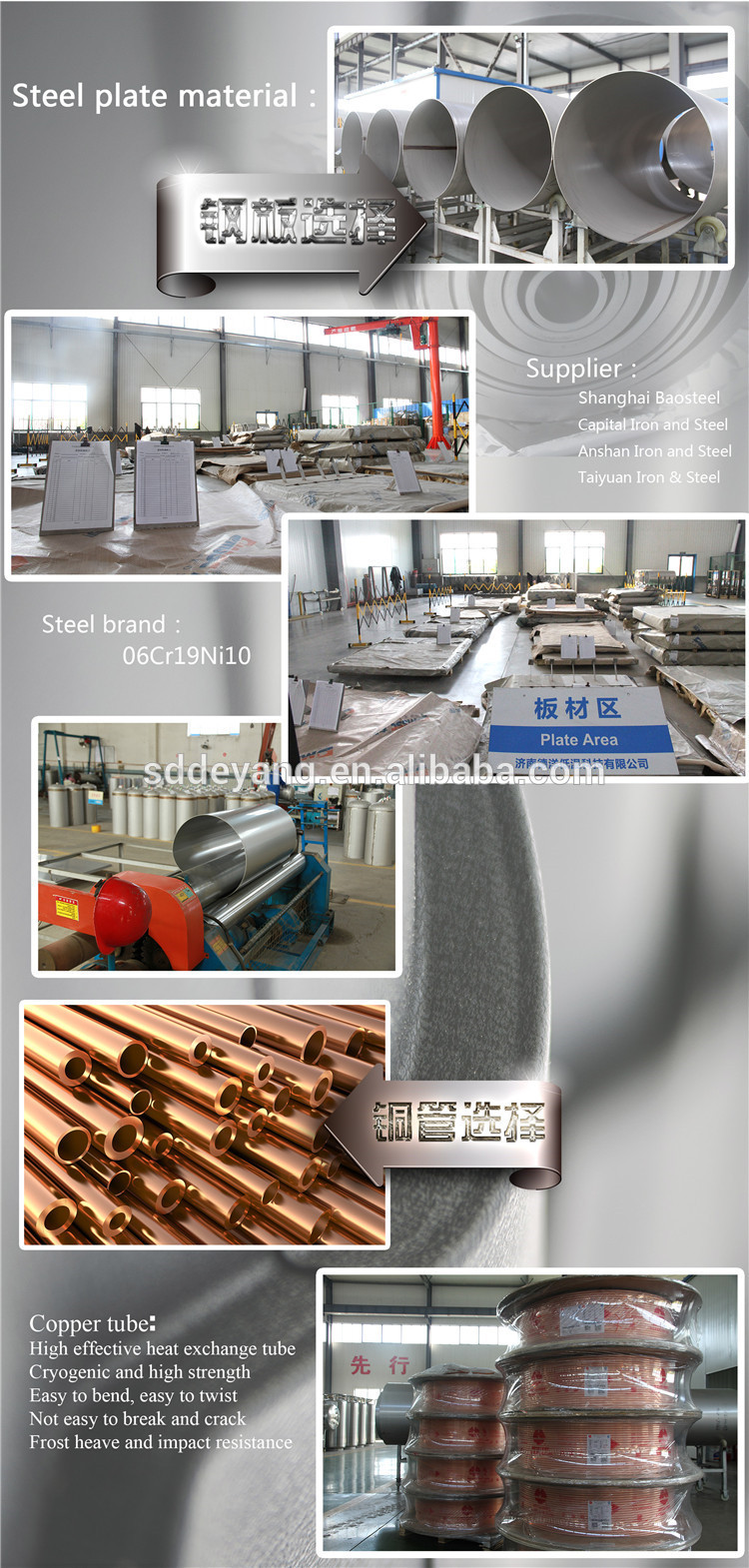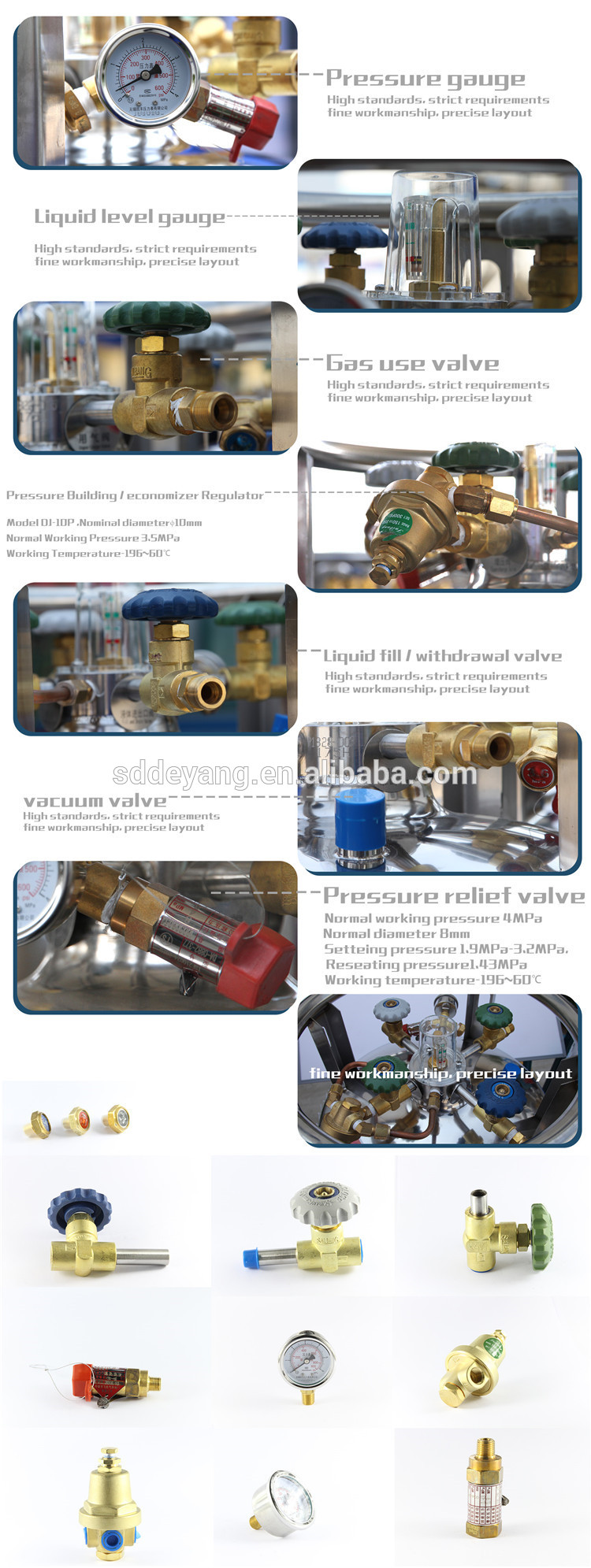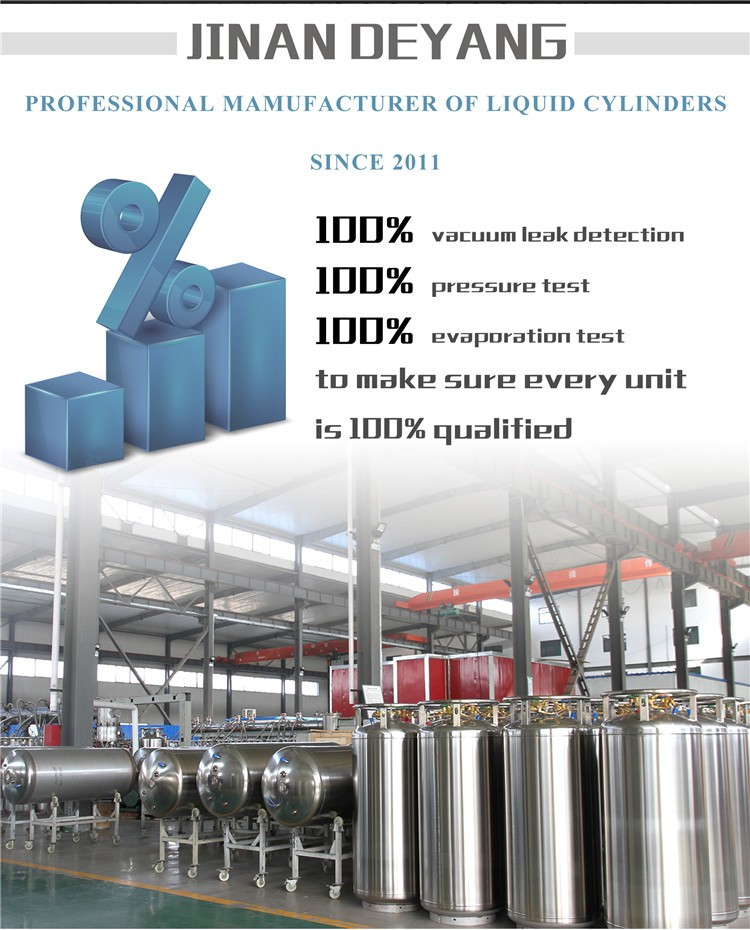Gas cylinder introduction
The DPL series of cryogenic cylinders produced by our company are vacuum insulated stainless steel containers designed for storing and transporting low temperature liquid oxygen, liquid nitrogen, liquid argon, liquefied natural gas or liquid carbon dioxide. They can transport cryogenic liquids and are widely used. In the fields of machinery, shipbuilding, medical, electronics, chemicals, food, materials, minerals, scientific research, etc.

Cylinder specific parameters
|
Model |
DPL450-195-1.4 |
|
Nominal capacity(Liters) |
195 |
|
Effective capacity(Liters) |
185 |
|
Medium |
liquid oxygen,liquid nitrogen,liquid argon,LNG |
|
Working pressure(MPa) |
1.4 |
|
Min working temperature (℃) |
-196 |
|
Hydraulic test pressure(MPa) |
2.41 |
|
Leakage test pressure(MPa) |
2.41 |
|
First safety valve open pressure(MPa) |
1.6 |
|
Bursting disk open pressure(MPa) |
2.6 |
|
Second safety valve open pressure(MPa) |
/ |
|
Evaporation rate for LN2 (M³/h) |
≤2.1 |
|
Evaporation rate for LNG (M³/h) |
≤1.7 |
|
Gas flow rate (M³/h) |
9.2 |
|
Empty weight (KG) |
134 |
|
Dimension(Diameter*Height)/(MM) |
Φ506*1626 |
|
Filling weight for LO2(KG) |
180 |
|
Filling weight for LN2(KG) |
140 |
|
Filling weight for LAr(KG) |
245 |
|
Filling weight for LNG(KG) |
75 |
|
Filling weight for CO2(KG) |
/ |

The series of welded insulated cylinders are high-strength liquid cylinders with double-layer structure: composed of inner and outer containers. The inner and outer biliary are insulative layers, and the heat insulating layer is provided with a plurality of layers of heat insulating material and maintains a vacuum.


Material Select


Both the inner and outer cylinders are made of stainless steel, and the supercharged coils are made of copper.
Among them,Steel plate material: stainless steel
Copper tube:high effective heat exchange tube cryogenic and high strength easy to bend ,easy to twist,Not easy to break and crack,Frost heave and impact resistance.
Valve and component introduction


♦Liquid fill/withdrawal valve: for filling and use of cryogenic liquids
♦Safety valve: pressure relief for the vessel above the maximum working pressure (automatic)
Note: Except for the periodic verification of the safety valve verification mechanism specified by the state, no user can adjust the valve by himself.
♦Vent valve: A gas used to remove the space in the bladder during filling of the container. While satisfying the smooth filling of the container, the filling pressure can be controlled.
Note: This valve can also be used as an exhaust valve to reduce the pressure of the container (internal pressure). However, when this valve is used as an exhaust valve, avoid excessive instantaneous flow and exhaust. This valve should not be opened for the rest of the time except when filling the cryogenic liquid and exhausting.
♦Pressure gauge: shows the cylinder liner pressure in psig or Kpa.
♦Level gauge: The level indicated by the gauge can only be approximated and should not be used for accurate metering. Accurate calculations must be weighed.
♦Gas use valve: used for the opening of the gas path of the gas vaporization circuit of the gas cylinder and the inlet port of the user gas.
♦Combination regulator: (1) preferentially use the part of the gas in the vessel inner gas chamber space above the set pressure;
(2) A control (limit value) for the maximum boost pressure (drive pressure) during the pressurization process. The adjustment range of the device is 0.34-2.38MPa (50-350psig).
Note: Under normal circumstances, users should not adjust this regulator. If the user wants to adjust, adjust the adjustment screw on the device. The adjustment method is: screwing in the clockwise direction - the pressure is increased, generally the pressure is increased by about 0.2 MPa per one turn; the counterclockwise twisting - the pressure is lowered, generally the pressure is reduced by about 0.2 MPa per one turn.
♦Vacuum valve: vacuum seal for container compartment space; also used for interlayer pressure relief.
Note: Do not move the valve at any time, otherwise it will cause damage to the container.
♦Vacuum bursting disc: used for venting pressure when the safety valve is not working properly.
Note: (1) The film can only be used once. After the membrane has been applied, it must be replaced.
(2) After the membrane has been applied, the safety valve must be sent to the nationally designated safety valve inspection mechanism before the new diaphragm can be replaced.
♦Pressure building valve: A conduit passage for opening the vessel pressure establishing system to enable the vessel to establish a certain driving pressure (internal pressure) to drive the cryogenic liquid in the vessel.
Note: This valve does not need to be opened unless the driving pressure (internal pressure) of the container is stable or the driving pressure (internal pressure) of the container is lower than the user's gas pressure. However, after each gas is used, be sure to check if the valve is closed. Otherwise, continuous internal circulation will waste the gas resources of the container.
Welding process
Welding includes: circumferential seam welding (head welding), vertical seam welding, valve welding, etc.

Specific test


♦vaccum test
In the manufacturing process of vacuum system,container and device,the vacuum tightness of them and the position of leak hole are determined by using the vacuum leak detection technology,so that measures can be taken to seal the leak hole so as to maintain the vacuum state in the system ,container and devcice
♦helium leak detection
Helium leak detector is a special instrument for leak detection with helium gas as leak indicator,it has stable performance and high sensitivity.
In addition, there are pressure detection, radiation detection,air tightness test,evaporation rate detection, component inspection, valve group inspection and appearance inspection, and the corresponding test report and certificate.
♦Safety device
The inner tank is designed with safety valve and secondary rupture disc to protect the cylinder during overpressure. In the case of overpressure, the safety valve is opened to relieve the pressure rise caused by the normal heat leakage loss of the structure such as the heat insulation layer and the support to the specified pressure rise or the vacuum is destroyed and under the condition of misfire. When the safety valve is disabled, the rupture disc will open to relieve pressure to ensure safe pressure inside the bottle.
The protection of the casing under overpressure conditions is achieved by means of a vacuum plug. If the liner leaks (resulting in a high jacket pressure), the vacuum plug will open to relieve pressure.
Method of use
Low temperature insulated cylinders are mainly used to transport liquids (liquid oxygen, liquid nitrogen, liquid argon, liquid carbon dioxide and LNG). Therefore, it can supply both liquid and gas (main function).
♦ Use gas
Use gas directly from the bottle: After the cylinder is filled with liquid and transported by road, there is usually a higher tank pressure, and the gas supply can be obtained immediately by opening the gas phase valve. If continuous air supply is required, the boost valve should be opened. (Where the cylinder will use the combination regulator to automatically adjust the liner pressure)
Tip: Increase the gas supply – you can connect two or more liquid containers together and use a manifold attachment to create a higher capacity gas supply system (DPL series vessels use only its built-in vaporizer at normal temperature and pressure) The gas supply flow rate is 9.2 m3/h. If a larger vaporization amount is required, an external vaporizer accessory can be used.
♦ Use liquid
Take the liquid directly from the bottle: When taking the liquid directly from the bottle, first determine that the pressure in the cylinder is higher than the pressure in the liquid equipment, so that the liquid in the cylinder flows into the liquid equipment through the pipeline and the valve by the pressure difference.
The following steps should be taken for liquid delivery:
(1) Connect the conveying pipe to the liquid phase valve. It is recommended to use a vacuum insulated hose for the conveying pipe.
(2) Connect the other end of the delivery tube to the liquid equipment.
(3) Open the liquid phase valve on the cylinder, which can adjust the flow rate of the liquid.
(4) When the delivery is completed, close the valve of the receiving device, close the liquid phase valve of the cylinder, and release the pressure in the delivery pipe to zero.
(5) Remove the duct from the receiving device.
Adequate inventory


The stock is filled to ensure that the customer's needs can be met.

100% vacuum leak detection
100% decompression test
100% evaporation test
To ensure that the quality of each product is qualified

Our company will hold some exhibitions on a regular basis to enable our customers to fully understand our cylinders.
At present, Deyang has exported low-temperature insulated cylinders to more than 30 countries and regions, such as Russia, Canada, Malaysia, Vietnam, Indonesia, Thailand, etc., and has received good feedback from domestic and foreign customers.
FAQ
♦Can you tell us more about the material of the cylinder and the specific test during the production process?
Our cylinders are all made of stainless steel. At the same time, in the specific production process, there will be vacuum detection, evaporation rate detection, component testing (bursting discs, etc.), valve group testing (pressure reducing valves, safety valves, etc.), appearance inspection, pressure testing, etc. And we issue corresponding test reports and certificates .In addition, there are leak detection, radiation detection, and air tightness testing to ensure 100% safety during use.
♦How is your cylinder different from other cylinders?
The cryogenic liquid cylinders we produced adopted the advanced techniques and the whole production process is under the strict quality-guarantee control system. It can be applied to store, transport the cryogenic liquefied gas products(liquefied oxygen, liquid argon, liquid nitrogen, liquid natural gas, liquid CO2,etc),and it can automatically provide continous gases.
1. Mainly used in storage and transportation of liquid oxygen, liquid nitrogen, liquid argon, and liquefied natural gas.
2. Superior product performance: welding technology is the first in China, vacuum performance is guaranteed for 3 years.
3. Adopted high multi-layer insulation method to ensure the low evaporation rate. Compared to companies of the same ability, the static evaporation rate (24 hours) of the cylinders we produce is the lowest in the country, averaging 1.7%.
4.The pressure-proof non-destructive time (that is, the pressure starts from 0 to the safety valve) is longer than the domestic holding time by 2-3 days, with an average of 11 days.
5. Inner vaporizer provides a 10Nm3/h stable continuous gas.
6. Solar installation use in the priority of gas-pressure and gas space.
7. Adopt the international CGA standard tie-in and all the valves installed imported from USA(REGO)
8. Unique design of damping ring meets the needs of frequent transportation.
9. Suitable for electronics, research, chemical industry, welding, and LNG supply industries.
♦What are the payment methods? Is there any promotion?
T/T
The price of a gas cylinder will be determined based on the amount. More than 10 vertical bottles (80L/175L/195L/210L/360L) will be offered at a discount of 15 dollars on the unit price; more than 5 horizontal bottles will be offered at a discount of 30 dollars on the unit price (410L/450L /500L). Price can be negotiated.
♦What is the after-sales service?
1. Have a professional team (engineer)
2. There are special testing institutions and knowledge (customers who purchase gas cylinders in our factory have discounts)
3. Quick repair (only need to vacuum, that is, do not throw away the outer cylinder, the cylinder can be sent to the customer within a week, and the old as new)
♦What accessories are there for your cylinders? What packaging?
The gas cylinder is standard as a hose, two joints. Packaging can be packed in wooden cases.